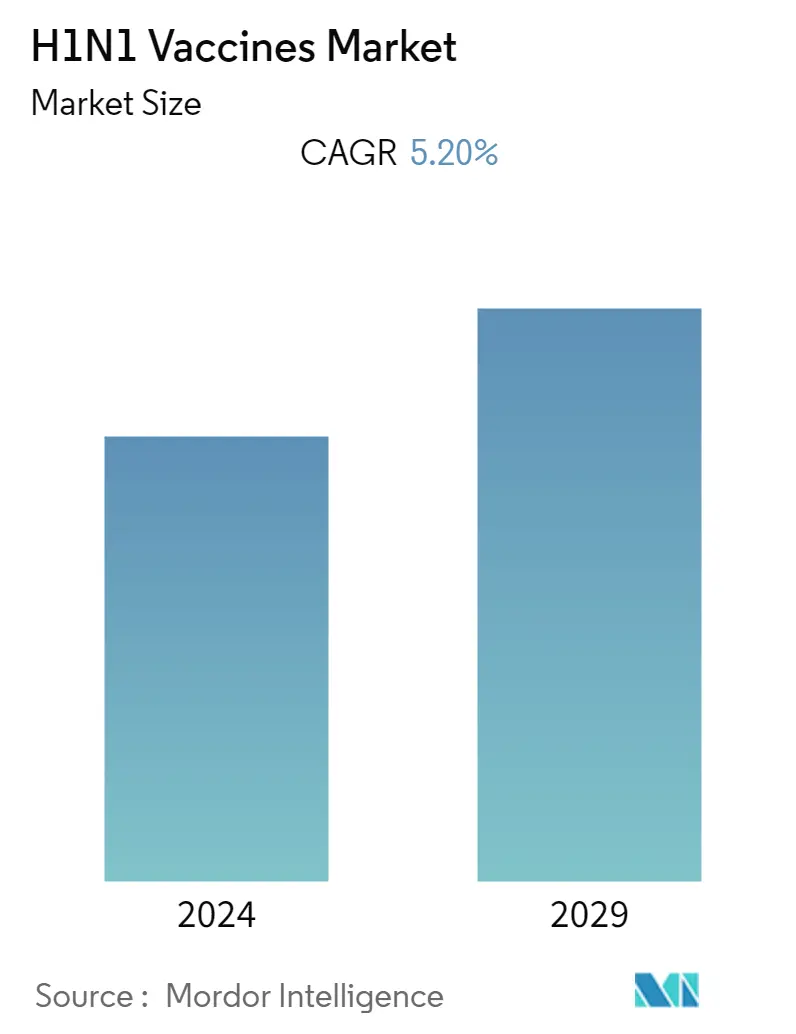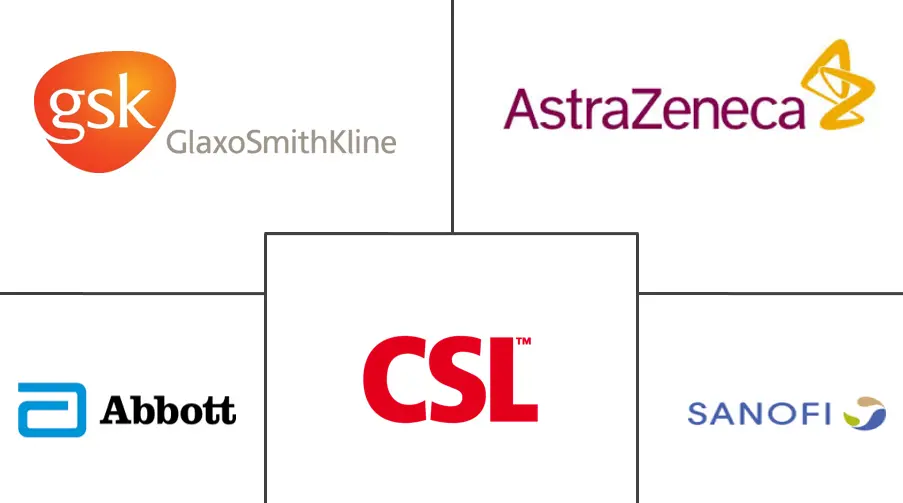Market Size of H1N1 Vaccines Industry

| Study Period | 2019 - 2029 |
| Base Year For Estimation | 2023 |
| Forecast Data Period | 2024 - 2029 |
| CAGR | 5.20 % |
| Fastest Growing Market | Asia Pacific |
| Largest Market | North America |
Major Players
*Disclaimer: Major Players sorted in no particular order |
H1N1 Vaccines Market Analysis
The H1N1 Vaccines Market is expected to register a CAGR of 5.2% during the forecast period. The H1N1 virus, commonly known as swine flu is an infectious disease in humans caused by the swine H1N1 virus, which is characterized by a persistent cough, cold, high fever, red watery eyes, body aches, headache, and general discomfort. H1N1 virus affects various species such as swine, birds, horses and other animals. The H1N1 virus is contagious and can spread widely through small droplets of saliva from coughs or sneezes of infected person. H1N1 virus causes damage to the respiratory system including nose, lungs, and throat. The H1N1 virus is a Ribonucleic acid (RNA) virus belonging to the Orthomyxoviridae family. In the year 2009, a strain of swine flu called "H1N1" infected many people around the world.
According to the World Health Organization (WHO), annually about 3 to 5 million cases of severe illness and about 2,90,000 to 6,50,000 respiratory deaths are due to seasonal influenza. In the case of industrialized countries, most of the deaths due to influenza occur among people above 65 years of age. Seasonal influenza illnesses range from mild to severe and even death.
Increasing incidences of epidemic H1N1 infection and declining immunity among the geriatric population and technological advancements in the vaccines are the key driving factors in the H1N1 vaccines market.
H1N1 Vaccines Industry Segmentation
The H1N1 virus, commonly known as swine flu is an infectious disease in humans caused by the swine H1N1 virus, which is characterized by a persistent cough, cold, high fever, red watery eyes, body aches, headache, and general discomfort. H1N1 Vaccines Market is segmented By Product Type, By Route of Administration and Geography.
| By Product Type | |
| Inactivated Vaccine | |
| Live Attenuated Vaccine |
| By Route of Administration | |
| Intradermal Vaccines | |
| Intramuscular Vaccines | |
| Intranasal Vaccines |
| Geography | ||||||||
| ||||||||
| ||||||||
| ||||||||
| ||||||||
|
H1N1 Vaccines Market Size Summary
The H1N1 Vaccines Market is poised for steady growth, driven by the increasing incidence of H1N1 infections and advancements in vaccine technology. The H1N1 virus, known for causing swine flu, poses significant health risks, particularly to the geriatric population with declining immunity. This RNA virus, part of the Orthomyxoviridae family, spreads easily through respiratory droplets and can lead to severe respiratory illnesses. The market is characterized by a strong demand for intramuscular vaccines, which offer rapid absorption and efficacy due to their delivery method. The rising prevalence of respiratory and immune-deficient diseases among older adults further fuels the need for effective vaccination solutions.
Regionally, North America is expected to maintain a dominant position in the H1N1 vaccines market, supported by robust government initiatives and a well-established healthcare infrastructure. The region benefits from advanced research capabilities and technological innovations in vaccine development. The market is consolidated, with a few major players such as MedImmune LLC, Sanofi Pasteur AG, and GlaxoSmithKline Plc leading the industry. These companies are instrumental in shaping the market dynamics, leveraging their expertise to address the growing demand for H1N1 vaccination and contribute to public health efforts.
H1N1 Vaccines Market Size - Table of Contents
-
1. MARKET DYNAMICS
-
1.1 Market Overview
-
1.2 Market Drivers
-
1.2.1 Increasing Incidences of Epidemic H1N1 Infection and Declining Immunity Among people
-
1.2.2 Technological Advancements in the Vaccines Field
-
-
1.3 Market Restraints
-
1.3.1 High costs of H1N1 Vaacines
-
1.3.2 Lengthy Manufacturing Process of H1N1 Vaacines
-
-
1.4 Porter's Five Force Analysis
-
1.4.1 Threat of New Entrants
-
1.4.2 Bargaining Power of Buyers/Consumers
-
1.4.3 Bargaining Power of Suppliers
-
1.4.4 Threat of Substitute Products
-
1.4.5 Intensity of Competitive Rivalry
-
-
-
2. MARKET SEGMENTATION
-
2.1 By Product Type
-
2.1.1 Inactivated Vaccine
-
2.1.2 Live Attenuated Vaccine
-
-
2.2 By Route of Administration
-
2.2.1 Intradermal Vaccines
-
2.2.2 Intramuscular Vaccines
-
2.2.3 Intranasal Vaccines
-
-
2.3 Geography
-
2.3.1 North America
-
2.3.1.1 United States
-
2.3.1.2 Canada
-
2.3.1.3 Mexico
-
-
2.3.2 Europe
-
2.3.2.1 Germany
-
2.3.2.2 United Kingdom
-
2.3.2.3 France
-
2.3.2.4 Italy
-
2.3.2.5 Spain
-
2.3.2.6 Rest of Europe
-
-
2.3.3 Asia-Pacific
-
2.3.3.1 China
-
2.3.3.2 Japan
-
2.3.3.3 India
-
2.3.3.4 Australia
-
2.3.3.5 South Korea
-
2.3.3.6 Rest of Asia-Pacific
-
-
2.3.4 Middle-East and Africa
-
2.3.4.1 GCC
-
2.3.4.2 South Africa
-
2.3.4.3 Rest of Middle-East and Africa
-
-
2.3.5 South America
-
2.3.5.1 Brazil
-
2.3.5.2 Argentina
-
2.3.5.3 Rest of South America
-
-
-
H1N1 Vaccines Market Size FAQs
What is the current H1N1 Vaccines Market size?
The H1N1 Vaccines Market is projected to register a CAGR of 5.20% during the forecast period (2024-2029)
Who are the key players in H1N1 Vaccines Market?
AstraZeneca Plc, Sanofi (Sanofi Pasteur AG), GlaxoSmithKline Plc, Abbott Laboratories and CSL Limited (Seqirus GmbH) are the major companies operating in the H1N1 Vaccines Market.

